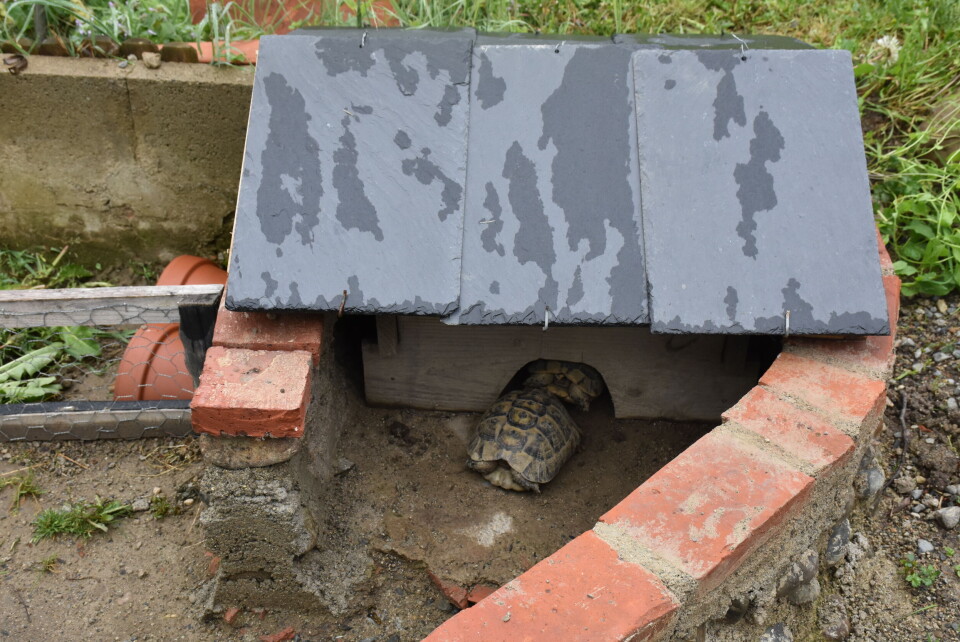-
January flowers in your French garden with scented viburnum
Our gardening columnist explores a pretty pink shrub that gives long-lasting winter displays
-
Lost cat reunited with French family after 11 years thanks to identification tattoo
Tattoo helped shelter to find owners of the injured, elderly cat
-
I lost my cat from French home - then the scammers moved in
Connexion reader in south-west France raises the alarm about missing pets after her own disappeared this summer
Progress on French DIY tortoise house is slow and steady...
Nick Inman charts the ups and downs of renovating an old French farmhouse

Never were there tortoises better provided for by a DIY enthusiast.
My son was given a pair some years ago and we were not sure what to do with them.
The challenge was to build them a decent home from spring to autumn. In the winter, they hibernate in a box in the barn.
Since then, we have acquired two more, smaller, tortoises and have experimented endlessly with how to build the perfect enclosure that allows enough space to move around but keeps them from getting out.
Our first attempt consisted of a frame made of timber battens, between which we stretched wire netting (stapled into place).
This had the advantage of being mobile: we could move the thing into the sun and put it away for the winter.
However, it was not as secure as we had hoped.
Tortoises are good at scraping a route underneath a perimeter fence and we had to put large stones in vulnerable places to stop them.
‘He has not been seen again’
The largest tortoise saw his opportunity. He walked up one of the stones and scrambled over the barrier to freedom. He has not been seen again.
Next, we decided to dig a permanent pit and surround it with a solid wall.
We chose a sunny spot and laid out a rectangle made of 5cm-wide grey blocks standing on foundations of rubble and cement.
I was pleased with our work – until there was a violent downpour one night.
I rushed out in my dressing gown to find tortoises floating helplessly in the rising water.
We had, without meaning to, built a swimming pool. I got there just in time to save them.
To avoid that happening again, we broke one of the end walls and extended the enclosure with more blocks.
This meant that rainwater would have more area to drain into.
We also provided some higher ground so that if there was another flash flood, the tortoises could climb to safety.
I was reasonably happy with it, but the straight lines upset the aesthetics of the garden and one corner stuck out into the driveway.
Back to work we went. We demolished a long wall, laid new foundations in a pleasing curve, and raised a barrier in the style of our region, using round river stones held together by lime mortar.
Imitation of our house
It is essentially an imitation of the structure of our house but using smaller stones – of which there is an abundance under the soil.
To finish the wall off, I cut some broken bricks into 10cm-wide strips with an angle grinder to serve as capstones.
Tortoises need shelter, as they do not like to be out in cold and rain.
Designing houses for them has turned out to be a great lesson in roof construction.
One end of the enclosure is covered with a shallow pitched roof of canal tiles, but I am particularly proud of the new house we have made.
My son put together an A-frame with scraps of wood and we have covered this with slates held in place with metal clips.
We have also been trialling different ways of dividing the space in the enclosure.
Our latest touch has been a removable wooden partition with a tunnel in the middle: a terracotta plant pot cut lengthways and fitted into a hole cut with a jigsaw.
Next I want to make a mosaic feeding platform. Nothing is too much for our tortoises.
Related articles
‘Old French house bricks have a character that is unique’
Drawing will help you get to the essence of a French building
French renovation: Why bricks don’t deserve ‘second best’ reputation
























